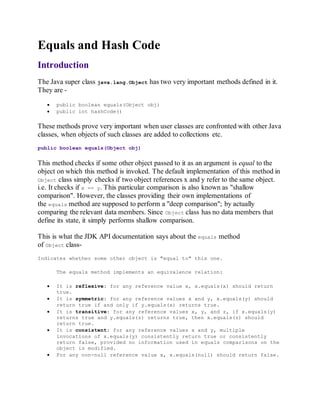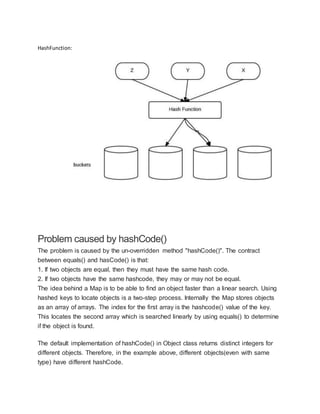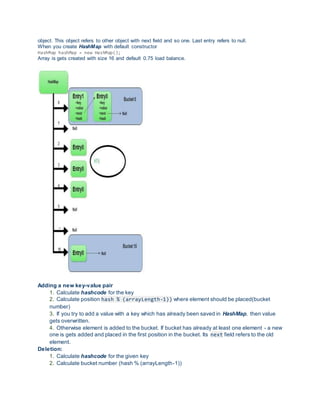The document discusses the equals() and hashCode() methods in Java. It provides:
1) An overview of the contracts and requirements for implementing equals() and hashCode() correctly, including that equal objects must have the same hashCode.
2) Details on how HashMap uses hashCode() to store and retrieve objects in an array based on their hash, potentially using linked lists for collisions.
3) An example of how not overriding hashCode() for a custom class can cause issues when adding objects to a HashMap, as unequal objects will have the same default hashCode(). Overriding hashCode() to return a unique value based on a field solves the problem.







![3. Get a reference to the first Entry object in the bucket and by means of equals method iterate
over all entries in the given bucket. Eventually we will find correct Entry. If desired element is
not found - return null
What put() method actually does:
Before going into put() method’s implementation, it is very important to learn that instances of Entry class
are stored in an array.HashMap class defines this variable as:
/**
* The table, resized as necessary. Length MUST Always be a power of two.
*/
transient Entry[] table;
Now look at code implementation of put() method:
**
* Associates the specified value with the specified key in this map. If the
* map previously contained a mapping for the key, the old value is
* replaced.
*
* @param key
* key with which the specified value is to be associated
* @param value
* value to be associated with the specified key
* @return the previous value associated with <tt>key</tt>, or <tt>null</tt>
* if there was no mapping for <tt>key</tt>. (A <tt>null</tt> return
* can also indicate that the map previously associated
* <tt>null</tt> with <tt>key</tt>.)
*/
public V put(K key, V value) {
if (key == null)
return putForNullKey(value);
int hash = hash(key.hashCode());
int i = indexFor(hash, table.length);
for (Entry<k , V> e = table[i]; e != null; e = e.next) {
Object k;
if (e.hash == hash && ((k = e.key) == key || key.equals(k))) {
V oldValue = e.value;
e.value = value;
e.recordAccess(this);
return oldValue;
}
}
modCount++;
addEntry(hash, key, value, i);
return null;
}
Lets note down the steps one by one:
Step1- First of all, key object is checked for null. If key is null, value is stored in table[0] position. Because
hash code for null is always 0.
Step2- Then on next step, a hash value is calculated using key’s hash code by calling
its hashCode() method. This hash value is used to calculate index in array for storing Entry object. JDK
designers well assumed that there might be some poorly writtenhashCode() functions that can return
very high or low hash code value. To solve this issue, they introduced another hash() function, and
passed the object’s hash code to this hash() function to bring hash value in range of array index size.
Step3- Now indexFor(hash, table.length) function is called to calculate exact index position for storing
the Entry object.](https://image.slidesharecdn.com/equalsandhashcode-150831161740-lva1-app6892/85/Core-Java-Equals-and-hash-code-8-320.jpg)
![Step4- Here comes the main part. Now, as we know that two unequal objects can have same hash code
value, how two different objects will be stored in same array location [called bucket].
Answer is LinkedList. If you remember, Entry class had an attribute “next”. This attribute always points to
next object in chain. This is exactly the behavior of LinkedList.
So, in case of collision, Entry objects are stored in LinkedList form. When an Entry object needs to be
stored in particular index, HashMap checks whether there is already an entry?? If there is no entry
already present, Entry object is stored in this location.
If there is already an object sitting on calculated index, its next attribute is checked. If it is null, and current
Entry object becomes next node in LinkedList. If next variable is not null, procedure is followed until next
is evaluated as null.
What if we add the another value object with same key as entered before. Logically, it should replace the
old value. How it is done? Well, after determining the index position of Entry object, while iterating over
LinkedList on calculated index, HashMap calls equals method on key object for each Entry object. All
these Entry objects in LinkedList will have similar hash code but equals() method will test for true equality.
If key.equals(k) will be true then both keys are treated as same key object. This will cause the replacing of
value object inside Entry object only.
In this way, HashMap ensure the uniqueness of keys.
How get() methods works internally
Now we have got the idea, how key-value pairs are stored in HashMap. Next big question is : what
happens when an object is passed in get method of HashMap? How the value object is determined?
Answer we already should know that the way key uniqueness is determined in put() method , same logic
is applied in get() method also. The moment HashMap identify exact match for the key object passed as
argument, it simply returns the value object stored in current Entry object.
If no match is found, get() method returns null.
Let have a look at code
/**
* Returns the value to which the specified key is mapped, or {@code null}
* if this map contains no mapping for the key.
*
* <p>](https://image.slidesharecdn.com/equalsandhashcode-150831161740-lva1-app6892/85/Core-Java-Equals-and-hash-code-9-320.jpg)
![* More formally, if this map contains a mapping from a key {@code k} to a
* value {@code v} such that {@code (key==null ? k==null :
* key.equals(k))}, then this method returns {@code v}; otherwise it returns
* {@code null}. (There can be at most one such mapping.)
*
* </p><p>
* A return value of {@code null} does not <i>necessarily</i> indicate that
* the map contains no mapping for the key; it's also possible that the map
* explicitly maps the key to {@code null}. The {@link #containsKey
* containsKey} operation may be used to distinguish these two cases.
*
* @see #put(Object, Object)
*/
public V get(Object key) {
if (key == null)
return getForNullKey();
int hash = hash(key.hashCode());
for (Entry<k , V> e = table[indexFor(hash, table.length)]; e != null; e = e.next) {
Object k;
if (e.hash == hash && ((k = e.key) == key || key.equals(k)))
return e.value;
}
return null;
}](https://image.slidesharecdn.com/equalsandhashcode-150831161740-lva1-app6892/85/Core-Java-Equals-and-hash-code-10-320.jpg)